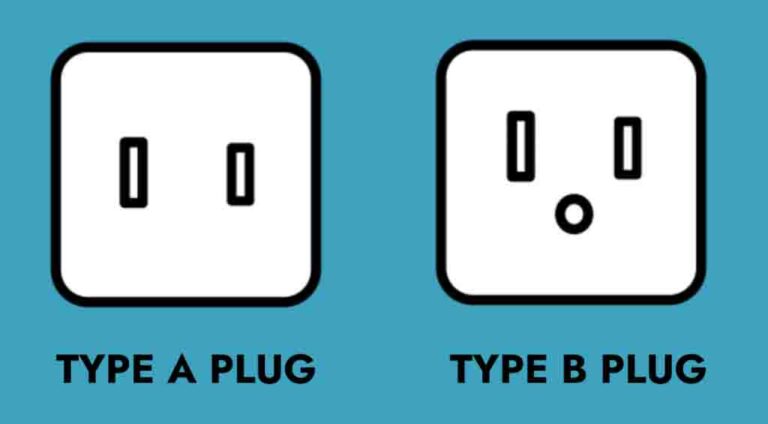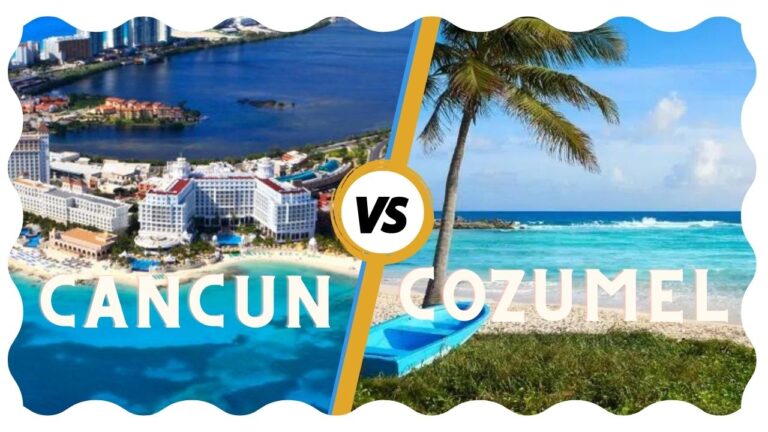Does Mexico Celebrate Halloween? A Guide about Halloween in Mexico
Halloween was first celebrated with the Celtic holiday of Samhain, which was far from Mexico. Yet, many are still asking: Does Mexico celebrate Halloween?
As a travel writer who resides in Mexico, I’ve witnessed firsthand how Halloween celebrations are celebrated in Mexico and how it differs from the one you’re accustomed to in the United States and other parts of the world.
In this article, we’ll discuss how Mexico celebrates Halloween and what to be prepared for during fun-filled celebrations across the country.
In addition, I’ll provide additional information on the important culturally-based Mexican holiday called “Dia of the Dead” (Day of the Dead) and how it differs from the traditional Halloween celebrations.
Are you interested in learning more about the details of Halloween in Mexico? Let’s get started!
Read Also: Does Mexico Celebrate Thanksgiving?
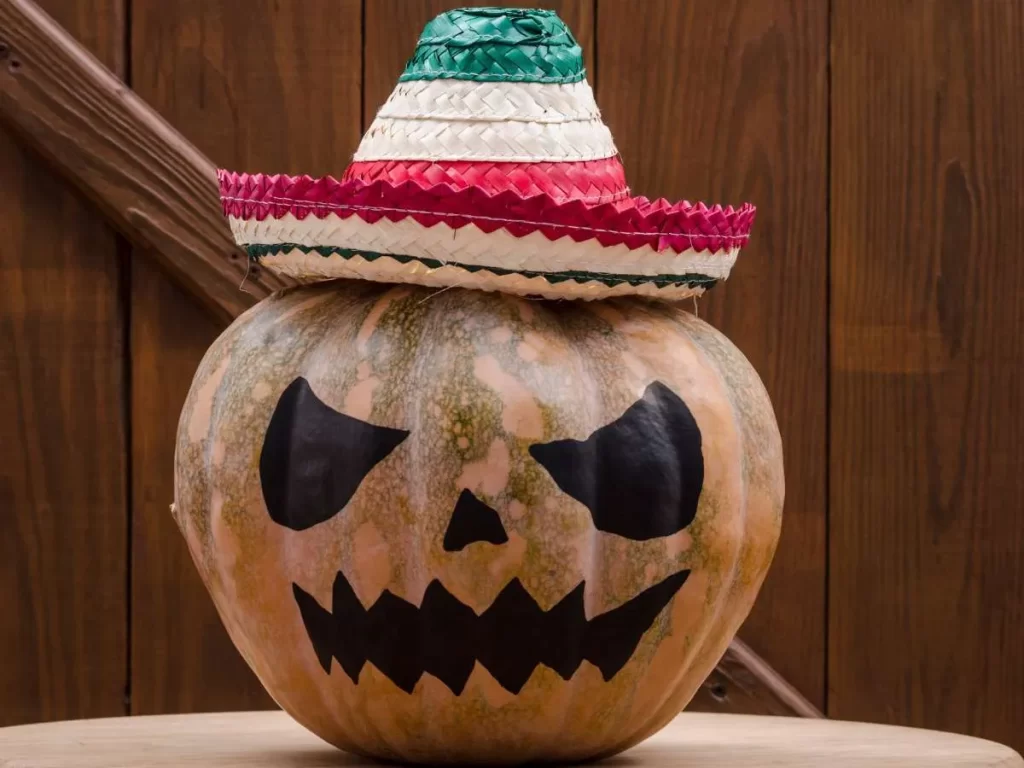
Does Mexico celebrate Halloween?
Yes, Halloween has been celebrated in many parts of Mexico. In the wake of the expansion of globalization and American media, Halloween celebrations have grown more popular and common in Mexico in recent years.
Little children dress in costumes and sing “Dulce or Truco” (Trick or Trick or) as well as “Queremos Halloween” (We Want Halloween) when they go Halloween-themed trick-or-treating.
It’s less well-known than the more popular and culturally significant Mexican holiday, Dia de los Muertos (Day of the Dead), between November 1 and 2.
When does Mexico celebrate Halloween and the Day of the Dead?
The Halloween holiday is observed on October 31 in Mexico. Halloween customs in Mexico are akin to those in the United States.
Halloween is celebrated by families dressing in costumes and trick-or-treating on the evening of October 31, as in America. United States.
However, it is believed that the Day of the Dead (Dia de los Muertos) is celebrated for a few days from November 1 to November 2.
Dia de los Muertos is far more well-known and considered a more significant celebration in all of Mexico.
With the increasing popularity of Halloween and the utmost significance of this Day of the Dead celebration, October’s end is a very exciting time of the year.
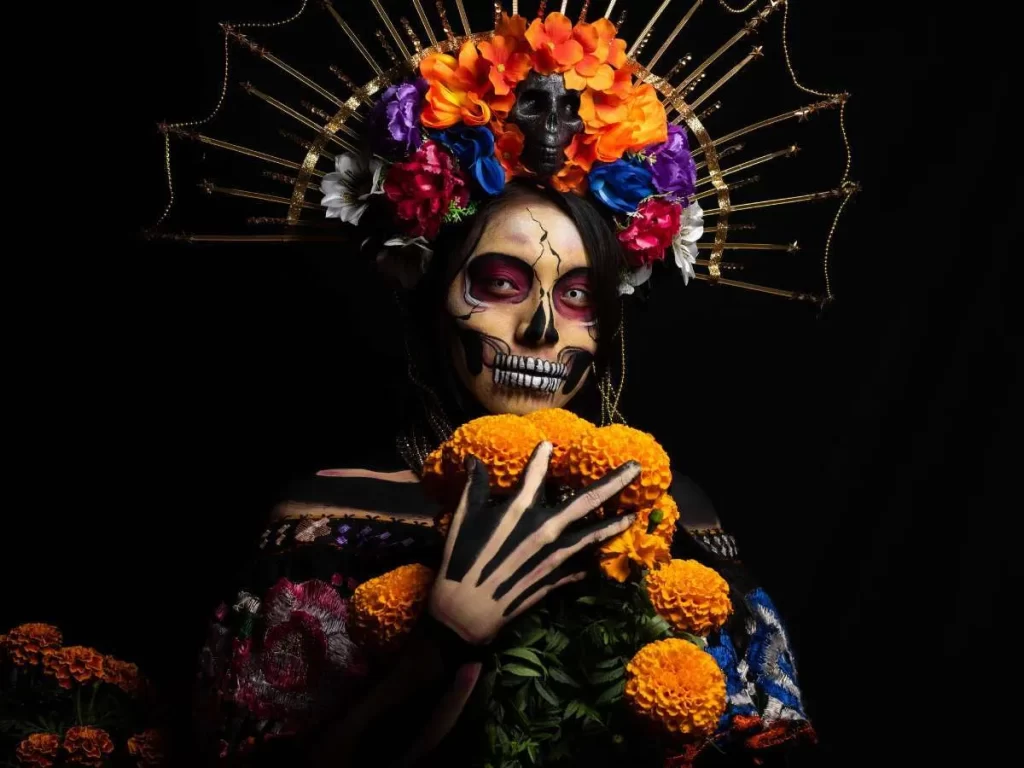
Why does Mexico celebrate Halloween?
Dia of Los Muertos is the king of the hill, as Mexican celebrations are among the most lively and memorable.
The idea of Halloween was quickly embraced and gained popularity among Mexican children as well as the local population.
Halloween’s rise could be largely attributed to popular culture and the increasing popularization in American media.
You may notice that Halloween is more popular and widely observed in communities that America influences.
How does Mexico celebrate Halloween?
Halloween celebrations in Mexico might look different based on the location in Mexico.
For instance, the states in Northern Mexico may be more heavily influenced by American media and culture because of the proximity.
Furthermore, coastal cities such as Cancun and Puerto Vallarta often cater to international tourists. Thus, they are more likely to celebrate Halloween as a fun event with costumes and parties.

My home is in Cancun; children dress up in costumes and trick-or-treat on the roads in Mexico City.
It’s not uncommon for some of the bar owners in Cancun to hold Halloween-themed parties, including drink specials and costume contests.
On the other hand, communities with a greater proportion of indigenous people are less likely to host elaborate celebrations and Halloween celebrations.

What is the Mexican version of the Halloween Celebration?
Many people believe that the Day of the Dead is the Mexican Halloween. Still, they have different roots in meaning, history, and significance.
Day of the Dead holds an important cultural significance. It’s an opportunity to reflect and pay respect to loved ones who have died. Family members are believed to be resurrected from the dead to celebrate this Day.
Day of the Dead festivities typically involves:
- Visiting graves to wash and decorate.
- Making altars for souls who have passed away.
- Even taking part in the procession.
What’s the difference between Halloween and Dia de Muertos in Mexico?
Halloween is a more commercial holiday that is primarily for entertainment.
On the other hand, this Day of the Dead holds significant historical and cultural significance. It is an occasion for celebration, reunion, and celebration of the cycle of life and death.
Halloween celebrations are filled with entertainment, fun, and costumes that highlight frightening or scary activities.
Day of the Dead Celebration
Day of the Dead is not intended to be spooky as Halloween. Instead, it is focused on the celebrations of death and life in a period where the dead can be returned from their final resting spot for the celebrations.
On this Day of the Dead, loved ones are remembered and honored as the bond with the past is nurtured and protected.
How does Mexico celebrate Dia de los Muertos?
Different areas of Mexico may have distinct Día de los Muertos traditions. However, most Day of the Dead celebrations are characterized by tiered altars in the home parades, various foods, symbolic decorations, and time with family.
Symbols of Día de los Muertos
Certain symbols are almost universal throughout Mexico in the Day of the Dead celebrations. Here are a few symbols that you might observe:
Tiered Altars (Ofrendas):
Tiered Day of the Dead altars are built in cemeteries, homes, and public areas. They typically consist of a number of layers, with photos of family members usually put on top. The lower layers generally are filled with traditional food, drinks, and personal possessions for all family members once they return home.
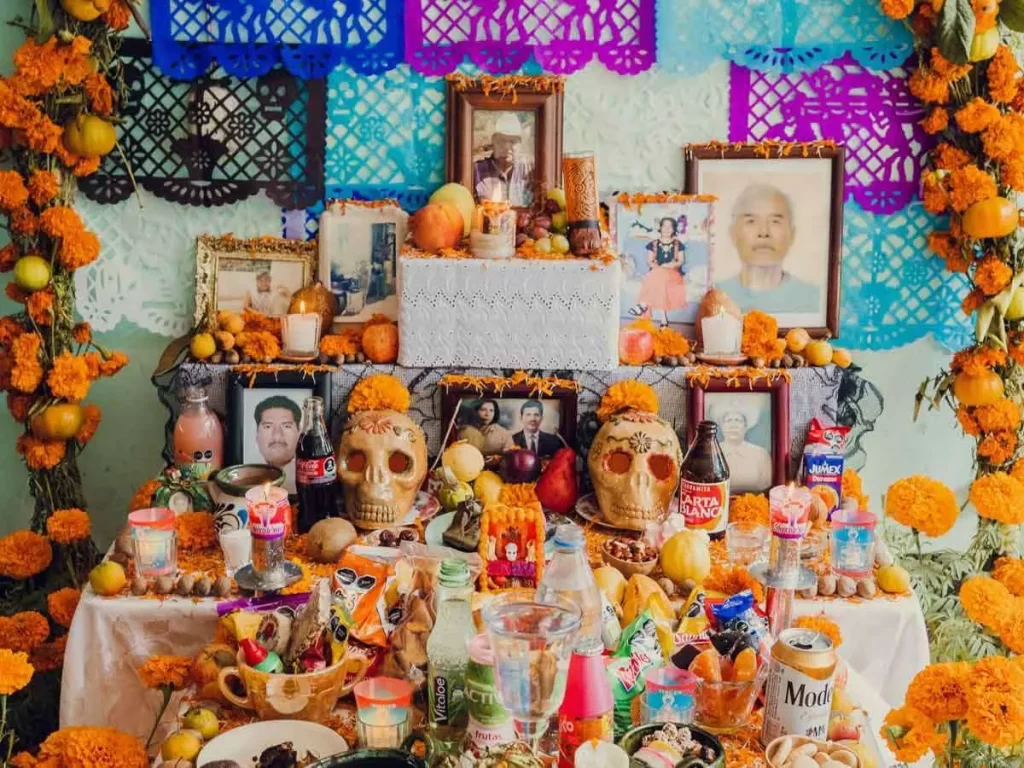
Marigolds (Cempasuchil):
Marigolds are believed to guide loved ones’ spirits back to their families after the festivities, thanks to their bright yellows, vibrant oranges, and strong scent.
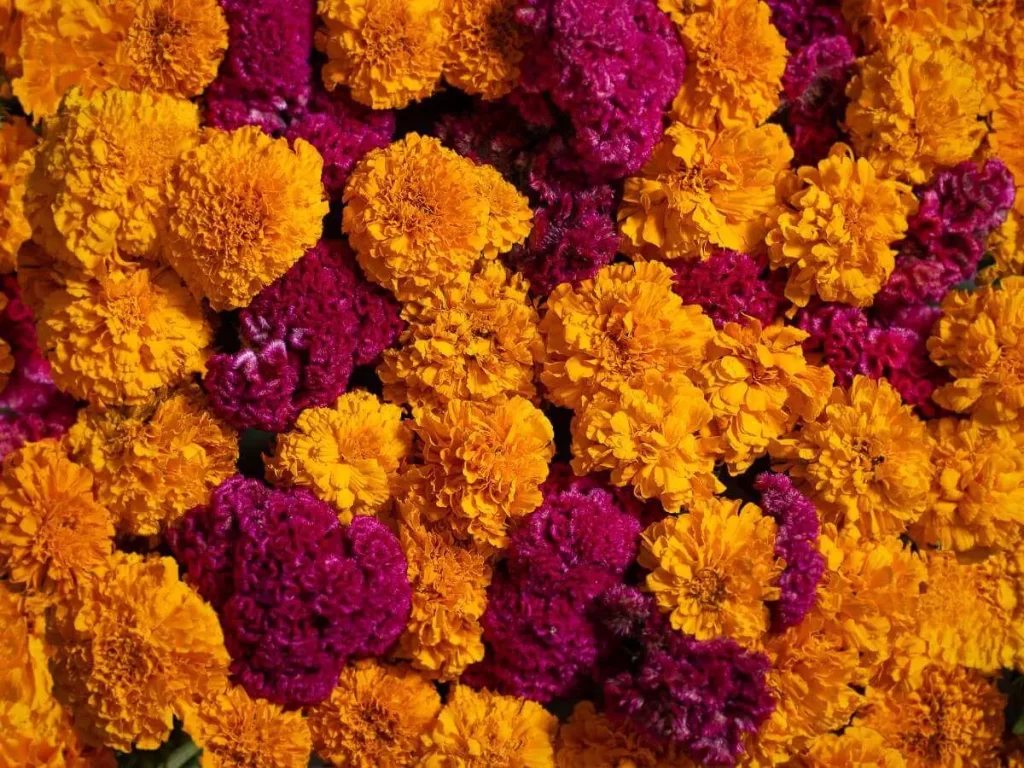
Papel Picado:
These are rectangular or square pieces made of thin, vibrant papers with elaborate designs that are cut. They are utilized for decoration and ornaments throughout the Day of the Dead festivities. They are believed to symbolize the fragility and delicateness in our lives.
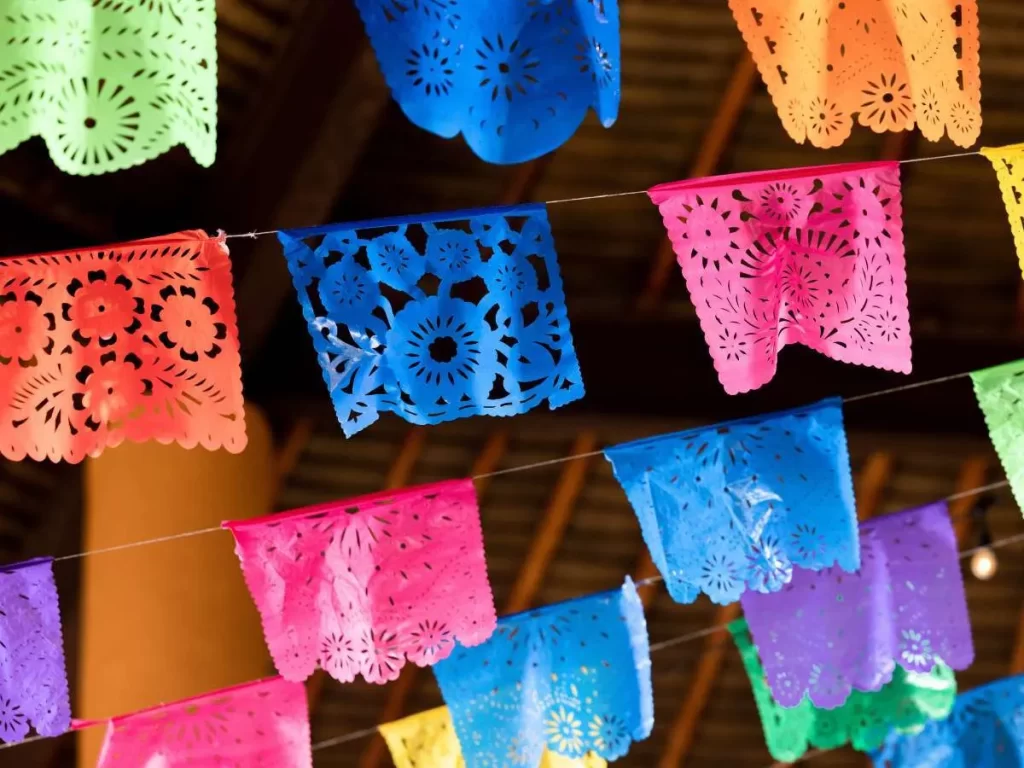
Sugar Skulls (Calaveras de Azucar):
The iconic sugar skulls are believed to represent the spirits of those who have passed away. Sugar skulls are typically customized and are placed on altars with tiered pillars.
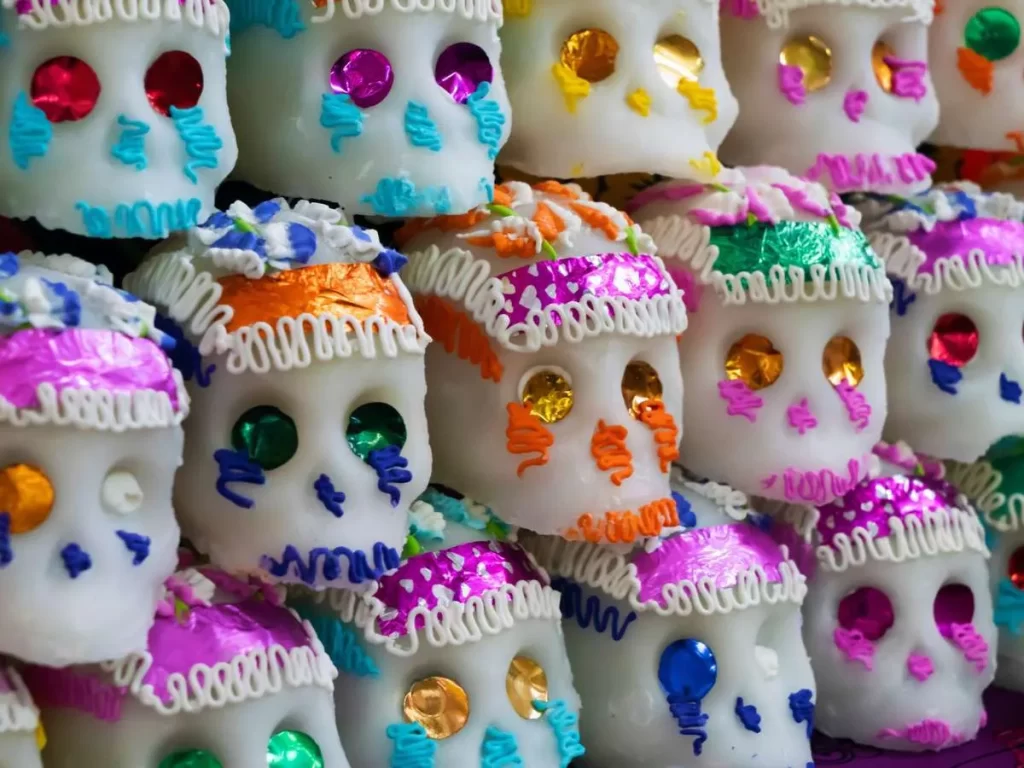
bread of the Dead (Pan de Muerto):
Bread of the Dead is a sweet traditional bread, usually oval or round, with bone-like designs covering the top. It is distributed at funerals to show hospitality and feeds souls who have returned to the alive realm. In addition, people consume the Pan de Muerto to keep contact with the dead and to nourish the spirit.
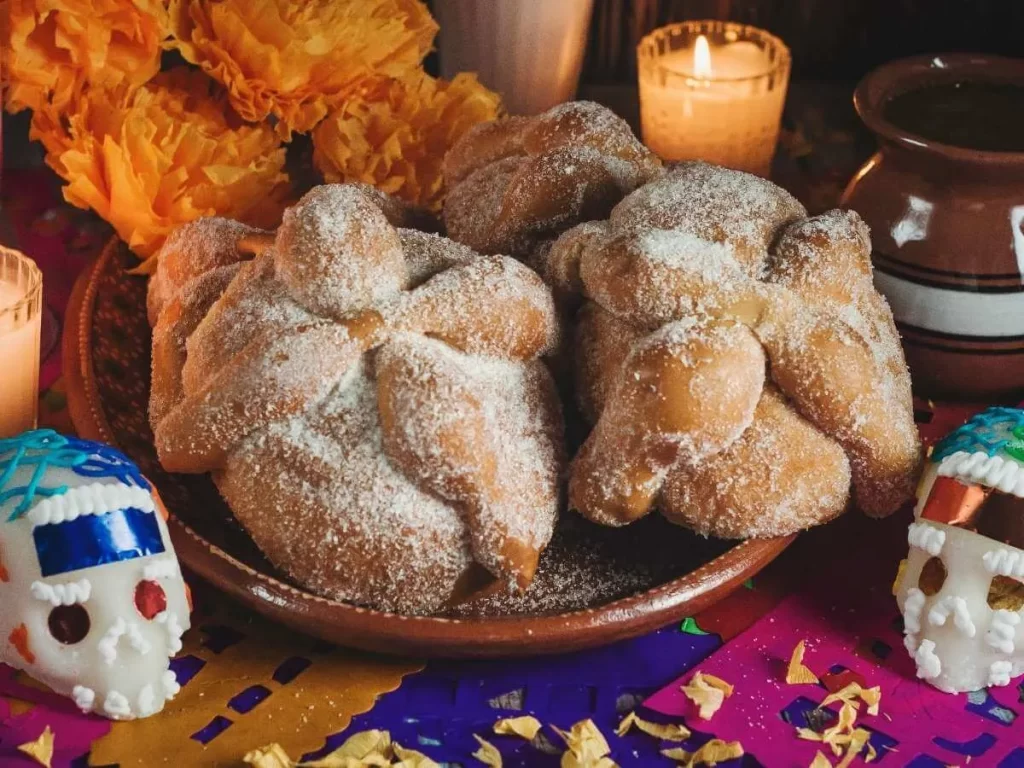
La Catrina:
The picture of La Catrina is now among the top well-known images associated with this Day of the Dead. It’s a beautiful female skeleton in a glamorous hat embellished with flowers.
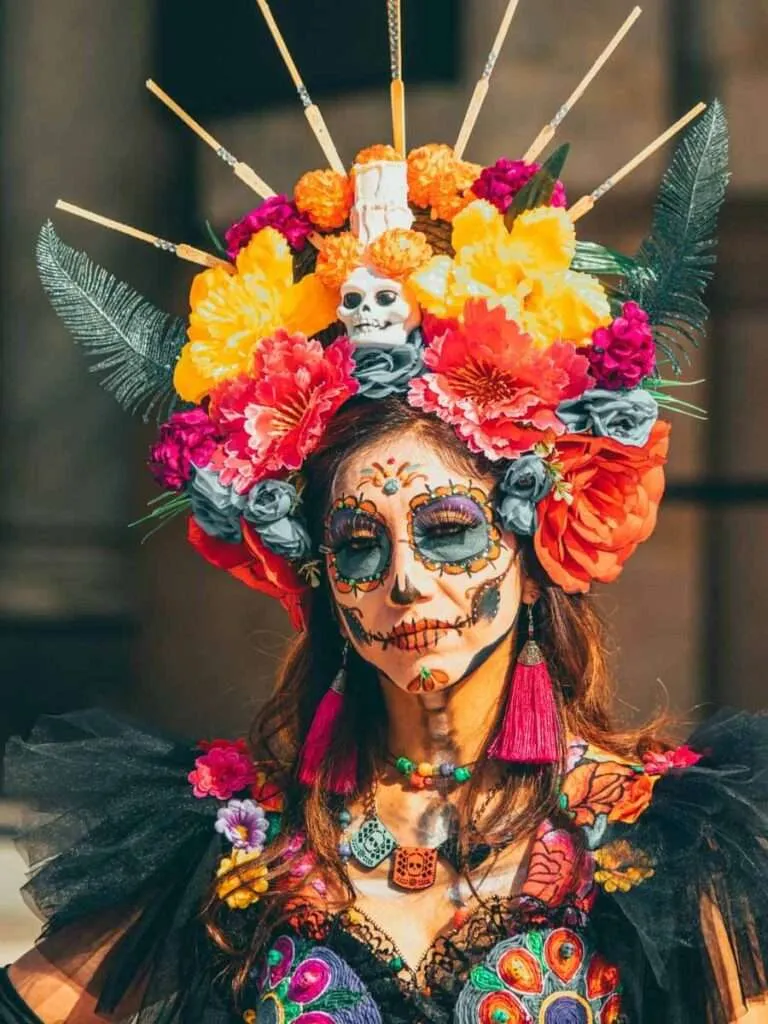
Calacas
Calacas can be described as skeletal figurines or figures that symbolize the spirits of the deceased. Skeletons with a whimsical look are typically depicted as engaging in fun activities like dancing and wearing bright clothes.
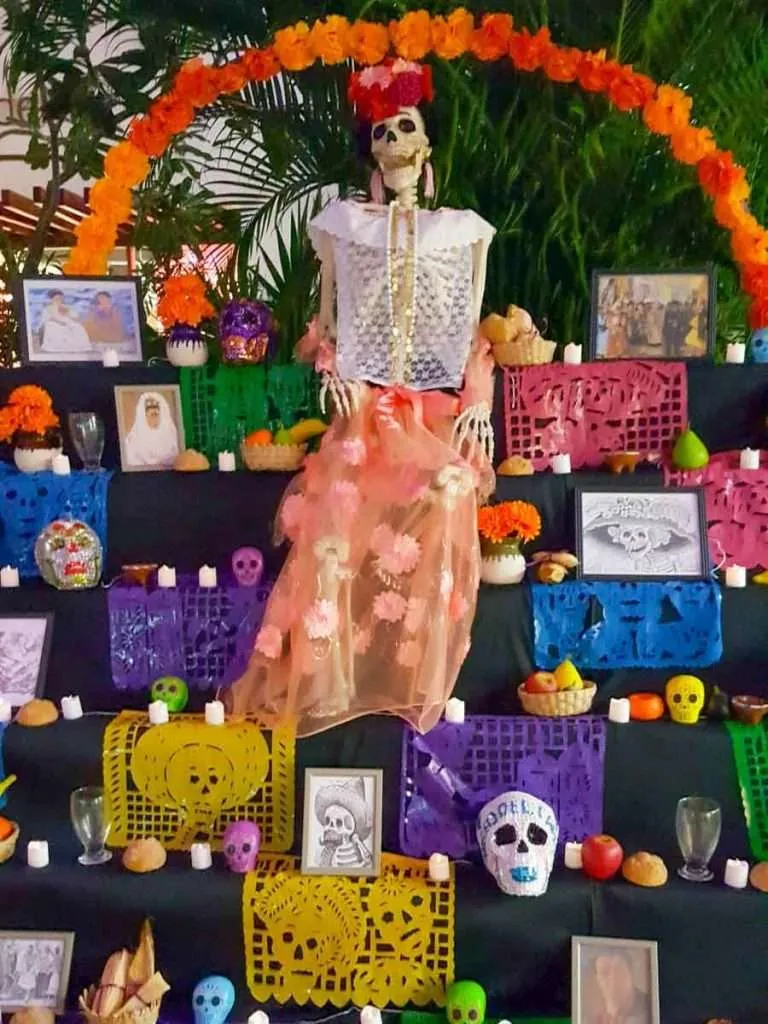
Ofrendas
The cemetery is a significant part of The tradition known as the Dead of the Dead, but not for the creepy atmosphere. Instead, Families go to the cemetery where their loved ones are laid to rest with “ofrendas, ” offerings.
The souls of the deceased are believed to come back to us during Day of the Dead celebrations. Families gather in the cemetery to share food and other possessions.
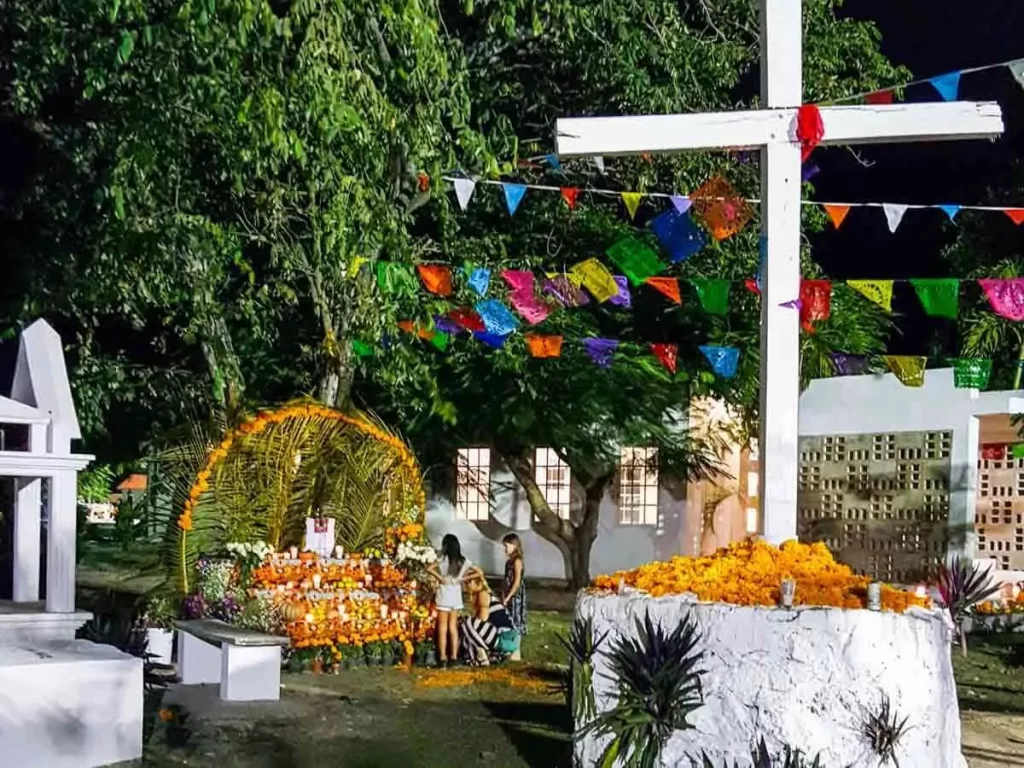
Parades and Cultural Celebrations
Celebrations of culture and parades are a vital part of the lively Day of the Dead celebrations.
Many major cities and small towns hold large-scale parades and events that celebrate the customs and customs associated with this time of the year.
La Catrina Parade is a popular event. La Catrina Parade is a well-known event that draws people to paint their faces and participate in vibrant dances and songs.
Another notable Mexican festival is the Festival of Life and Death Traditions, which takes place at Xcaret Park in the Riviera Maya region.
This event is one of the best ways to celebrate the Day of the Dead in Playa del Carmen, Cancun, or Tulum. It is an immersive experience into every aspect of the captivating traditions of Día de Muertos.

When is the Day of the Dead celebrated in Mexico?
The Day of the Dead is believed to be celebrated from November 1 to November 2. It encompasses All Saints Day and All Souls Day. But the celebrations typically start about a week before that Day of the Dead.
- All Saints Day (November 1) honors deceased or dead children.
- All Souls Day (November 2) honors deceased adults.
All Souls Day, on November 2, is the officially recognized Day of the Dead.
Best places to celebrate the Day of the Dead in Mexico
Numerous lively cities take part in this Day of the Dead. Here are a few of the best places to get immersed in the vibrant celebrations and the rich customs:
Oaxaca City
Oaxaca City is one of Mexico’s best cities where you can celebrate The Day of the Dead. The Central Mexican city is famous for its extravagant and entertaining events for this Day of the Dead.
In the evenings that lead up to November 2, families and communities gather at cemeteries to celebrate evening vigils, also known as Velas.
Candles are lit, people sing songs, and share stories about loved ones as they clean and decorate graves.
Oaxaca City also hosts buzzing parades running from one side of town to the next and through all squares filled with fantastic local music and infectious energy.

Mexico City
The largest city in Mexico and also the capital, there is no surprise that the Halloween celebration in Mexico City is real. For that reason, it’s one of the best cities for celebrating this Day of the Dead!
Mexico City hosts a mega ofrenda in the Zocalo (main square), an enormous altar displaying symbolic altarpieces.
The ofrenda comprises four large altars arranged in four cardinal directions (North, South, East, and West).
Mexico City also hosts a huge grand parade called “the Parade of Las Catrinas. The train runs through Mexico City’s streets, featuring tradition-based music, dance, and joyous celebrations.
The very first Day of the Dead parade wasn’t until 2016; however, it has become an annual event.
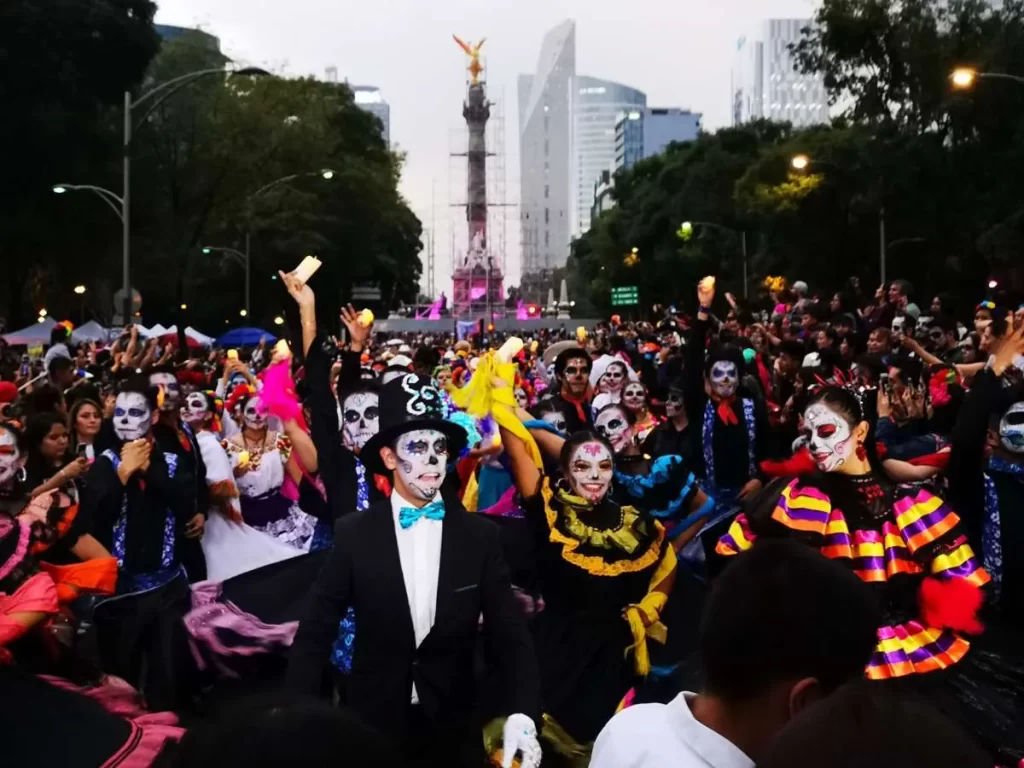
Merida
Suppose you want to travel towards the Yucatan peninsula. In that case, consider going to Merida for The Day of the Dead celebrations.
Merida is a thriving, vibrant, colorful and vibrant city in the beginning. It’s becomes an even more captivating city in winter due to their unique twist on the Day of the Dead.
Merida is a celebration with huge altars in every public square in Merida’s city. Also, they have lavish decorations, unique Yucatan food, and warm temperatures, even in October!
Halloween in Mexico: FAQs
Here are the solutions to commonly asked questions regarding Halloween in Mexico:
Is Halloween a big deal in Mexico?
Halloween in Mexico isn’t an issue. However, it is becoming well-known. Children and families are likely trick-or-treating down famous streets and dressed in creepy Halloween costumes.
Is Halloween different in Mexico?
Halloween lovers in Mexico are similar to people in the United States or other countries. But Mexico celebrates its Day of the Dead on November 1st and 2nd.
It is a Day of the Dead that differs entirely from Halloween and is a celebration filled with ceremonies and Mexican traditions tightly linked with traditional Mexican culture and people.
How do Mexicans do on October 31?
Halloween celebrations on October 31 in Mexico usually include costumes, parties, trick-or-treating in shopping malls, bustling neighborhoods, and even themed bar celebrations.
Halloween isn’t a typical Mexican holiday, so that the celebrations may differ across different regions of Mexico.
Do children in Mexico have to trick-or-treat?
The practice of trick-or-treating is increasingly popular among children in Mexico, particularly in cities and communities influenced by American culture.
Some families even let their children trick or treat for three days starting October 31.
What is the word they use in Mexico rather than “trick or treat”?
Children sing “Queremos Halloween,” meaning “We want Halloween”! It is also possible to hear “Dulce O truco” (trick or treat) or “Me da my Calaverita” (Give me my tiny skull).
What is the meaning of the Halloween celebration in Mexico?
Halloween in Mexico It is generally referred to as “Halloween”; however, it can be called “Dia of the “Brujas” (Day of Witches).
Dia de los Muertos (Day of the Dead) is a distinct holiday celebrated following Halloween between November 1st and 2nd.
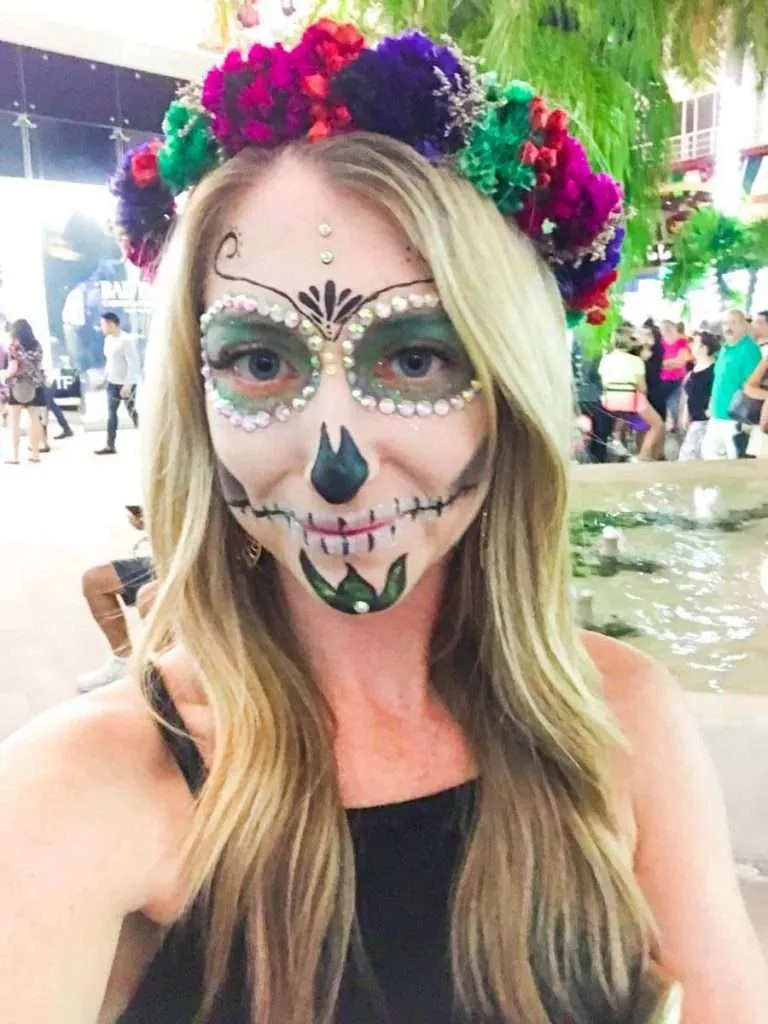
Conclusion: Halloween in Mexico Guide
Is Halloween celebrated in Mexico? Yes, Mexico celebrates Halloween.
Because of the globalization process and American media’s influence on the world, the candy-filled Mexican Halloween celebrations have grown more popular in Mexico in the past few years.
It’s less well-known than the traditional Dia de los Muertos (Day of the Dead).
Although Halloween has found its place in Mexican tradition, It’s important to understand and appreciate the richness and importance of the Day of the Dead, a vital element of Mexico’s identity and tradition.
We hope that now that you’re equipped with all the knowledge and information about Halloween in Mexico, You’ll be able to participate in or take in the festivities in Mexico comfortably!



